Ventilation in the house from sip panels: the best options and layouts
If you like warmth more than cool, or live in a cold region, then housing from SIW panels is quite suitable for you. But along with the heat, you will get a house where the air often stagnates, the smell quickly worsens, a lot of moisture accumulates and becomes stuffy. So that ventilation in the house from SIP panels does not reduce its usefulness and is powerful enough, you need to think about air exchange in different weather.
You must admit that it doesn’t hurt to read about this before you start building. If you are already the owner of such a house, then there is the opportunity to improve it thanks to the steps that we wrote about.
We have prepared a simple manual on ventilation in the house from SIP, but with all the details. You will be able to understand which of this is better, simpler and more justified. The article has almost no general information, except for brief information about the features of the material.
The content of the article:
Why do we need SIP panels?
Housing from SIP panels does not need insulation, but will not be comfortable without good ventilation. Its walls do not let through almost anything. Get ready for the need for a well-developed air distribution system. There are three main options for its organization.
SIP panel (structurally insulated, or structural insulated, panel) is a type of sandwich panels. It consists of two large oriented particle boards (OSB) with insulation injected or glued between them.
SIPs are used in low-rise construction. Houses get good protection from external factors. Thanks to high-quality wood and chip-laying technology, the walls will have sufficient mechanical strength.

Buildings from SIP panels receive a lot of usable area and built-in thermal insulation. They are built in warm and cold weather, in a short time thanks to simple assembly technology.
A house made of self-supporting insulated wires, like the rest of the frame buildings, needs effective ventilation. Due to the fact that the walls do not allow air to pass through, condensation and dampness appear.
Pipes in SIP-houses are selected with sound insulation, as the materials and the construction of the walls / floors significantly enhance the sounds.
Ventilation of houses from SIP panels
In cold weather, more moisture condenses in the building from SIW panels than in other houses. In summer, condensation also appears actively, but mostly only on windows. When designing, you will have to pave the way for air ducts, find places for valves, the unit supply and exhaust ventilation. Around the same time as for other utilities.
In each room, it does not hurt to install one ventilation hole, and in the kitchen - both exhaust and supply. The most difficult will be with air exchange in technical rooms: in bathrooms, kitchens, rooms without windows for household purposes.
There are general requirements for air exchange:
- constant movement of air, its renewal;
- uniform ventilation of all rooms;
- elimination of dirty air;
- comfortable temperature;
- lack of drafts.
For normal air exchange, natural ventilation with supply and removal of air is required. To the natural (windows, ventilation ducts with gravity) add fans and ducts with superchargers.
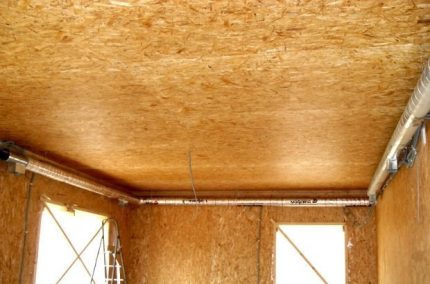
The second question is how to make balanced ventilation: to increase the usual or shift the emphasis to heat transfer or mechanical fans running on the mains.
Option # 1 - improved ventilation scheme
It is a natural supply and exhaust system in combination with mechanical ventilation as an auxiliary.
In this case, separate exhaust ducts are made for the kitchen, bathroom, toilet, rooms without windows and small rooms. Pipes ideally combine into one at the level of the upper floor / attic / attic and lead over the roof through one hole.
Supply system collected from one pipe on the roof and lowered to the height of the attic, give it a horizontal position. The channel at this level is laid to the maximum length. Ideally, the pipe on both sides reaches the most distant places in the house from each other. Already from this horizontal branch channels are diverted to each residential premises and, if desired, to technical ones.
The exhaust and supply parts of the system are combined in a block in the attic. A heat exchanger is sometimes installed in the assembly. The latter are often used as elements of adequate ventilation.
The supply and exhaust unit usually looks like a box with four holes. Supply and exhaust ducts enter and exit them. The inflow pipe above the block should be made curved and horizontal from the side of the street - so that air can more easily get inside.
To clean the air mass does not hurt to install a filter. They try to keep the air exhaust channel as straight as possible from the block and to the space above the roof.
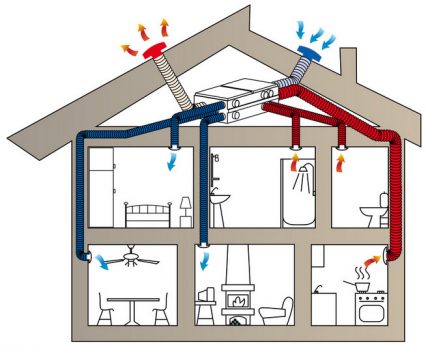
The branches of the main channels for supplying and removing air lead to the upper parts of the premises. At the end of the supply air ducts, controlled valves are installed. The exhaust ducts are closed with trellised hatches, and they are positioned as far as possible from the entrance openings.
Poor circulation rooms provide portable fans. In the kitchen they put a mechanical hood over the stove, and the duct of this device is directed to the street. In a private house, you can do this.
The whole system is supplemented with passive ventilators. Devices work in two modes. The supply and exhaust is due to the pressure difference.There is still through ventilation, which is organized by two such devices.
Option # 2 - use of mechanical devices
Intended ventilation shafts become clogged over time. With this in mind, we can go the other way. Add superchargers powered by a power source. We calculate their power so that they can perform their tasks without the help of natural air exchange.
Installing mechanical ventilation in a house from SIP panels will not be easier than installing natural.
Good mechanical ventilation consists of:
- several independent exhaust ducts;
- supply fans;
- valves of various types.
Let's start with the exhaust system. Mechanical fans can be installed in finished pipes or in separate ones with the ability to realize a more efficient design. We make at least 2-3 exhaust outputs on the roof.
Inside the house we lower the channels to the bathroom, toilet, kitchen, basement. Preference should be given to a system with fans in the inlets and in the roof tops.
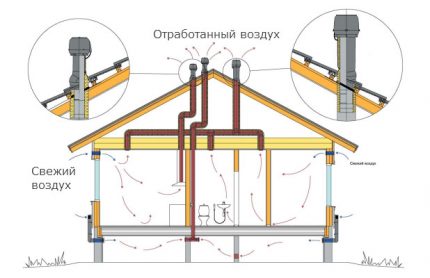
We organize the inflow through the wall supply fans. We place them on the outer walls, one per room, and in the basement two on opposite sides. In rooms without external walls we bring in supply channels with access through the roof.
Some simply leave small openings in these rooms for air to enter from the outside. These passages are closed with plugs.
Supply fans for walls are of two types:
- for installation on a wall;
- for installation in the thickness of the wall.
Install them from the inside, that is, in the house.
Unforgettably wall valves three types, including mixed supply and exhaust. We place them where air exchange is expected to be weaker. In the kitchen, add a valve to the glass pane profile. This type of window vent provides powerful micro-ventilation. We make the cooker hood autonomous, supply it with an adsorption filter.
In which case we add a supply and exhaust fan in a window or in a wall. Most of all, the device is suitable for kitchens. We can deactivate it at any time, and for the cold time the device will have to be turned off. The system is not suitable for ventilation without other devices.
Option # 3 - ventilation with recovery
There is also an option with high power ventilation, and so that the air does not get too cold, it should be heated somehow. Read more about what is heat recovery Further.

Bring benefit supply air heatersdue to which it becomes possible to supply a lot of air from the street without violating the temperature regime. The devices operate on a coolant, and their fans are powered by an electric motor. Air passes through the housing and enters warm.
Thermal comfort is achieved in other ways. Circulation systems take air out of the house. There he mixes with the street. This mass is sucked in. As long as the resulting air reaches the rooms, it will become warm and will be much fresher. It will not leave harmful substances and unpleasant odors.
Another option is a recuperator. The device uses warm air from different sources of heat (cooker hood, etc.) or just from the room. In the exchanger, the air gives off heat and then goes outside, and then the cold street heat from it. The transfer of thermal energy is due to the ceramic element that can accumulate it. The outer end of the recuperator is protected by a visor from gusts of wind, snow and rain.
If the temperature difference is more than 40 degrees between the room and the street, the incoming air will be about 5 degrees colder than the leaving one. Energy efficiency at home will remain high.
From the side of the facade of the house, the hole is placed a little lower, so that the warm and cold streams move better. Recuperators can be installed in several rooms at once. First of all, in those where there is access to the external wall, as well as in the basements.
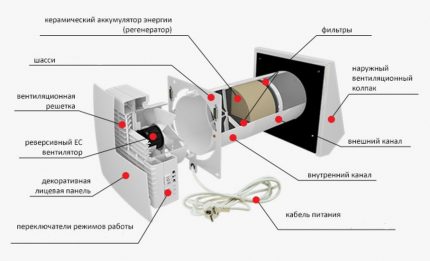
Recuperators have an electric motor and several speeds (usually three). At the maximum, medium-power devices take about 10 watts. If you add up the power of all such devices for a large house, then the energy consumption will turn out to be low. Only the initial costs will be high.
Consider the preparation of recuperators for installation on the example of one unit:
- Remove the casing-shell of the device.
- We connect the wires. We simply fix them as needed: special adapters should already be installed on the recuperator. After installation, connect the device to the mains.
- We take out the filter from the tube, which was covered by the outer shell.
- On the surface there will be a line with serifs. The closest to the room edge of the recuperator indicates the minimum permissible length of the appliance.
- We take into account the thickness of the walls. At the outside in the SIP-house, it most often equals 124 mm, 174 or 224 mm. Usually it is not enough for the recuperator to completely “hide” in the wall.
- We cut off the tube - we are guided by the markup. If the wall thickness is insufficient, we shorten the notch closest to the room side.
- We recess the filter back.
- If the walls are not thick enough, we simply install a hood - at the installation site of the heat exchanger inside or outside the house. Sometimes it comes bundled.
Recuperators are sometimes installed without a shell, but with a dense layer of thermal insulation. So they achieve the highest density when the available hole diameters do not match the casing parameters.
If you find a more or less suitable crown for cutting, you can mount the ventilation yourself: in a SIP-house, the walls are easy to drill.
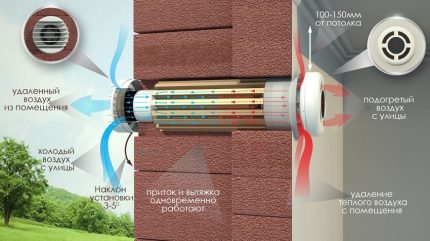
If you will mount the hood from the outside, but it does not match the relief of the facade, then simply cut it and seal it with sealant.
Buildings from SIW panels retain heat well, it makes no sense to spend a lot on heating the incoming air. Moreover, warm time takes up a considerable part of the year. According to the heat-insulating properties of SIP, the panel is more than five times more effective than brickwork.
At a temperature below 10 ° C without preliminary heating it will still be bad, and at negative - the incoming cold air eliminates the whole effect of SIP panels.
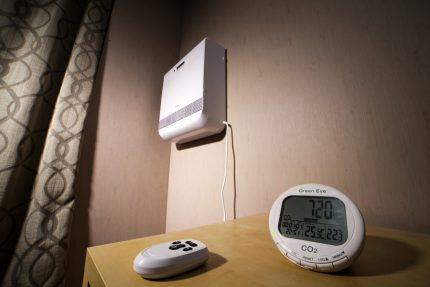
The task is simplified by selective forced ventilation. Parts of the building are excluded from the street air supply system. You can not do without a well-thought-out layout of rooms where air makes fewer turns. The supply system is ideally distributed to all rooms.
They make valves with an adjustment plug in the hole. They are placed at a height of 0.5 meters above the floor, and the installation site is sealed with foam. With a well-organized inflow of other appliances, less is needed, and the rooms will always be fresh and warm.
Conclusions and useful video on the topic
Video instruction for installing ventilation devices in the premises of the house from self-supporting insulated wire:
Installation of a supply valve with detailed explanations:
The nuances of organizing ventilation in a SIP-house according to the features of a particular structure:
You read about the strengths of SIP-houses and what will definitely make itself felt. Think about enhancing existing ventilation. Add mechanical devices. Make them the main source of fresh air if its condition is unsatisfactory.
Assemble a new system with high traffic, a large number of sleeves. Think of powerful heated systems for incoming air. Such you install with the least effort.
Write comments and ask questions. Tell us about the amenities and disadvantages of your home from SIP panels. Write how successful you think the ventilation is in it. The feedback form is located below.

 Is it possible to bring ventilation to the attic in a private house? The best accommodation options
Is it possible to bring ventilation to the attic in a private house? The best accommodation options 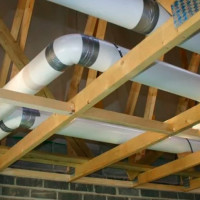 Ventilation from plastic sewer pipes in a private house: the possibility of construction and the best options
Ventilation from plastic sewer pipes in a private house: the possibility of construction and the best options 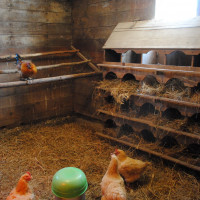 DIY ventilation in the chicken house in winter: the best schemes and subtleties of arrangement
DIY ventilation in the chicken house in winter: the best schemes and subtleties of arrangement 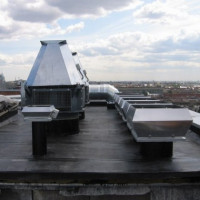 Schemes for arranging ventilation systems in an apartment building
Schemes for arranging ventilation systems in an apartment building 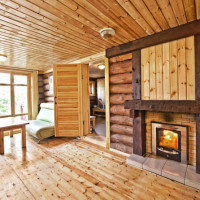 Ventilation in the dressing room: options and methods for arranging the air exchange system
Ventilation in the dressing room: options and methods for arranging the air exchange system 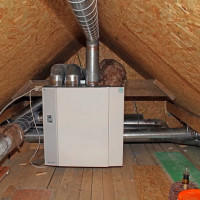 Ventilation in a two-story private house: options for organizing trouble-free air exchange
Ventilation in a two-story private house: options for organizing trouble-free air exchange  How much does it cost to connect gas to a private house: the price of organizing gas supply
How much does it cost to connect gas to a private house: the price of organizing gas supply  The best washing machines with dryer: model rating and customer tips
The best washing machines with dryer: model rating and customer tips  What is the color temperature of light and the nuances of choosing the temperature of the lamps to suit your needs
What is the color temperature of light and the nuances of choosing the temperature of the lamps to suit your needs  Replacement of a geyser in an apartment: replacement paperwork + basic norms and requirements
Replacement of a geyser in an apartment: replacement paperwork + basic norms and requirements